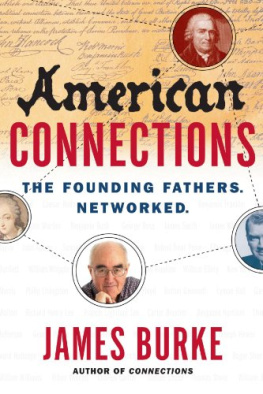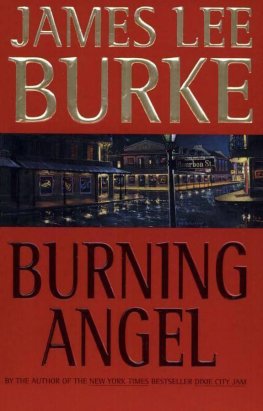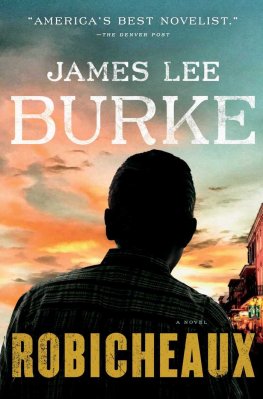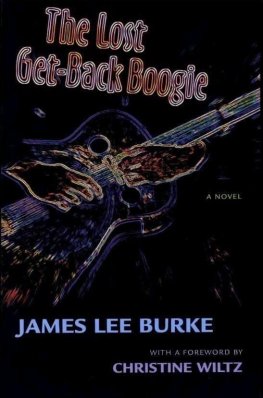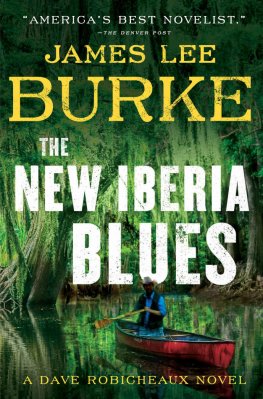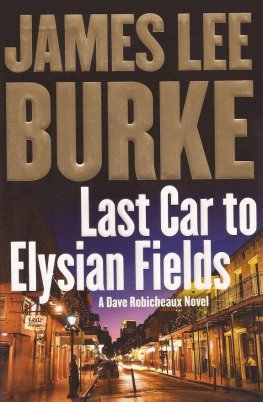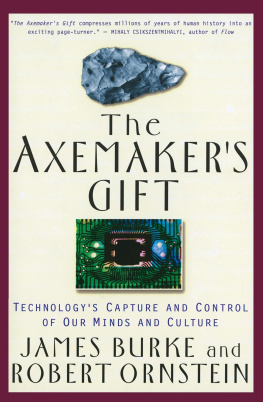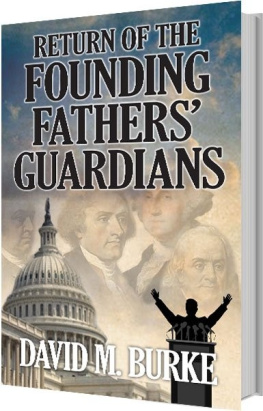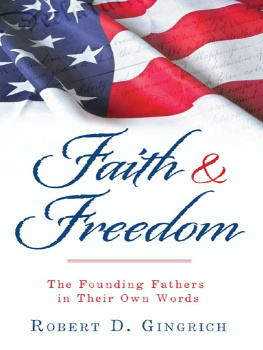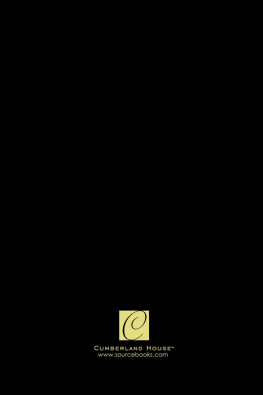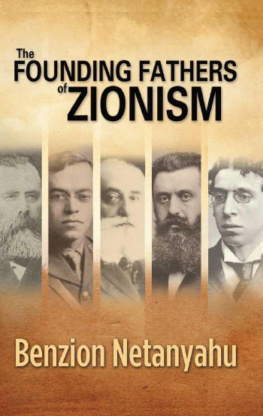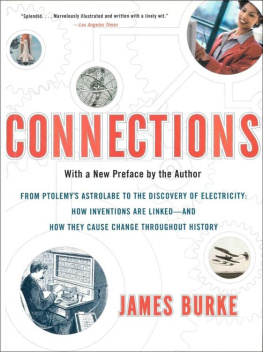James Burke - American Connections: The Founding Fathers, Networked
Here you can read online James Burke - American Connections: The Founding Fathers, Networked full text of the book (entire story) in english for free. Download pdf and epub, get meaning, cover and reviews about this ebook. publisher: Simon & Schuster Adult Publishing Group, genre: Non-fiction. Description of the work, (preface) as well as reviews are available. Best literature library LitArk.com created for fans of good reading and offers a wide selection of genres:
Romance novel
Science fiction
Adventure
Detective
Science
History
Home and family
Prose
Art
Politics
Computer
Non-fiction
Religion
Business
Children
Humor
Choose a favorite category and find really read worthwhile books. Enjoy immersion in the world of imagination, feel the emotions of the characters or learn something new for yourself, make an fascinating discovery.
- Book:American Connections: The Founding Fathers, Networked
- Author:
- Publisher:Simon & Schuster Adult Publishing Group
- Genre:
- Rating:4 / 5
- Favourites:Add to favourites
- Your mark:
- 80
- 1
- 2
- 3
- 4
- 5
American Connections: The Founding Fathers, Networked: summary, description and annotation
We offer to read an annotation, description, summary or preface (depends on what the author of the book "American Connections: The Founding Fathers, Networked" wrote himself). If you haven't found the necessary information about the book — write in the comments, we will try to find it.
American Connections: The Founding Fathers, Networked — read online for free the complete book (whole text) full work
Below is the text of the book, divided by pages. System saving the place of the last page read, allows you to conveniently read the book "American Connections: The Founding Fathers, Networked" online for free, without having to search again every time where you left off. Put a bookmark, and you can go to the page where you finished reading at any time.
Font size:
Interval:
Bookmark:


Twin Tracks
Circles
The Knowledge Web
The Pinball Effect
Connections
The Day the Universe Changed
The Axemakers Gift
(with Robert Ornstein)


SIMON & SCHUSTER
Rockefeller Center
1230 Avenue of the Americas
New York, NY 10020
Copyright 2007 by London Writers
All rights reserved,
including the right of reproduction
in whole or in part in any form.
S IMON & S CHUSTER and colophon are registered trademarks of Simon & Schuster, Inc.
Library of Congress Cataloging-in-Publication Data
Burke, James, 1936
American connections : the founding fathers networked / James Burke.
p. cm.
Includes bibliographical references.
1. United States. Declaration of IndependenceSignersBiography. 2. StatesmenUnited StatesBiography. 3. LegislatorsUnited StatesBiography. 4. PoliticiansUnited StatesBiography. 5. United StatesHistoryRevolution, 17751783Biography. 6. United StatesHistory17831815Biography. 7. BiographyMiscellanea. 8. HistoryMiscellanea. I. Title.
E221.B95 2007
973.3'130922dc22
2007003500
ISBN-13: 978-0-7432-9871-1
ISBN-10: 0-7432-9871-3
Visit us on the World Wide Web:
http://www.SimonSays.com
To Madeline
I should like to express my grateful thanks to Jay Hornsby and Patrick McKercher for their meticulous and rewarding help in research.
Thanks are also due to Jack Kelly for his painstaking care with the artwork.
T he trouble with iconic heroes like the Signers of the Declaration of Independence (note the reverential uppercase) is that theyre like stuffed exhibits in museum casespassed by thousands of children sleepwalking their way through an educational tour, who never visit the signers again. Most of us dont remember their names.
Heroes also become imbued with virtues we wish on themsuch characteristics as honesty, selflessness, and courage in the face of danger. And while it is true that what the signers did was dangerous and could have got them strung up, not all were honest and few if any were selfless. Nearly half of them would much have preferred some kind of compromise with the British. One of them even repudiated his signature. And of course the Brits regarded them all as what would today be called terrorists.
One reason for this book is to remind readers briefly of the signers flesh-and-blood characters: Some were crooks, some had dysfunctional families, some were involved in financial shenanigans, some were masters at political backstabbing, many were egomaniacs, and a few were just good people.
The other reason for the book is to connect these men to the reader and the modern world. Historical figures are always a surprisingly short distance away in time. You may have heard your grandfather speak of his grandfather, who talked about his grandfather. Thats when the signers lived. Theyre close. And not so different from us.
The past feels like a foreign country only because of all those wigs and breeches and strange behavior. But think: In the 1960s men had shoulder-length hair and wore flared pants. In the 1950s, before contraceptive pills, unmarried motherhood was a disgrace. Behind their contemporary fashions and social rules the signers were essentially much like us. Of course marvels like electricity and airplanes and computers would be incomprehensible to them. But if you were transported to the eighteenth century, would you know how to send a letter or even how to write it? How to prepare a quill pen and a sheet of parchment? And how would you dry the ink? What was the equivalent of an envelope? Its a mistake to think that people in the past were different or stupid just because we dont think they could handle our modern technology. Given time, even a caveman could learn to use a computer. And, by the way, the Upper Paleolithic was only five hundred grandfathers away.
Ive tried to link the signers even more directly to us with an approach Ive been using for thirty years, which has recently become known as six degrees of separation. In this way each signer triggers a chain of events that links him to the modern world through a series of connections: Someone he knew knew someone who knew someone, and so on.
These trails through history show how incredibly diverse are the ties that connect us to each other, back and forward in time and space. The network linking the signers and their modern counterparts is peopled by spies, assassins, cuckolds, fraudsters, murderers, the incestuous, bomb-throwers, pillmakers, inventors, artists, musicians, statesmen, royalty, explorers, infanticides, transvestites, counterfeiters, con men, doctors, lovers, heroes, scientists, clergymen, and a host of others. And if you look far enough, you, too, are linked to this network. You are linked to the signers. We all are. It may be a few more than six connections, but not that many more.
In a medium other than print I might have been able to offer each reader (user?) the means to make his own connections so as to become part of the narrative. Perhaps at some point in the future this book will take that form and youll be able to make the connections yourself. Meantime, next best (and half-proving the point), Ive connected each signer to someone or something bearing his name in the modern world.
Why write a book like this? Well, writing beats real work. And I hope youll find it diverting. History is where we come from, so its worth a look. And as navigators say: you dont know where youre going if you dont know where youve been.
And perhaps theres a more serious reason. In a world fast becoming more interdependent and interconnected, where change happens faster than ever because of the way people and ideas connect, we are all on a communications network of some sort and we feel the effects of change much more quickly than even only a decade ago. Innovation comes so frequently now that by the time you understand how some new gizmo works its already obsolete. We need to learn to handle accelerating rates of change by becoming more aware of how change happens. One way to do this is to think more connectedly than we have been educated to do. Because if an event in Uzbekistan is going to cause the closure of the company we work for in Oshkosh, the sooner we find ways to second-guess that event the better for us.
I hope this book will provide an example of interconnected thinking that will encourage you to try it, too.
One last note: Many people believe the Declaration was signed on July 4. In fact that was the date of the congressional vote agreeing to the wording of the document. On July 5 a version was printed and signed by John Hancock (president of Congress) and Charles Thomson (secretary), and this was distributed to state assembles and other interested groups. On July 19 Congress ordered a formal version (in special formal handwriting) to be printed and when this was ready, on August 2, fifty-one delegates finally signed. Five delegates were absent for reasons of ill health or army duties, and these men signed later on. A few congressional delegates never signed.
London 2007
Font size:
Interval:
Bookmark:
Similar books «American Connections: The Founding Fathers, Networked»
Look at similar books to American Connections: The Founding Fathers, Networked. We have selected literature similar in name and meaning in the hope of providing readers with more options to find new, interesting, not yet read works.
Discussion, reviews of the book American Connections: The Founding Fathers, Networked and just readers' own opinions. Leave your comments, write what you think about the work, its meaning or the main characters. Specify what exactly you liked and what you didn't like, and why you think so.

